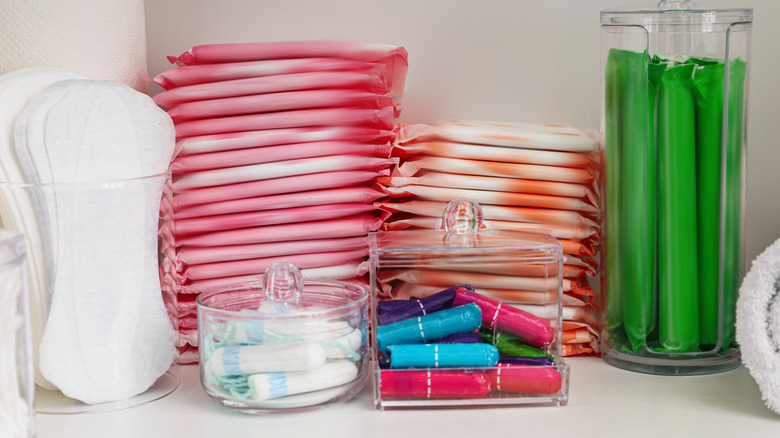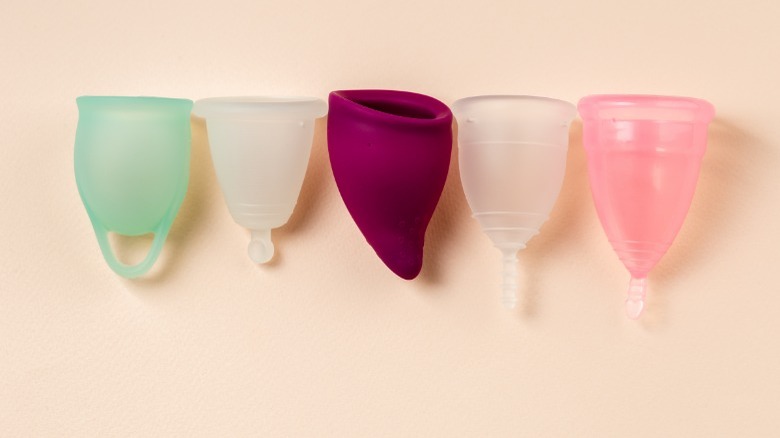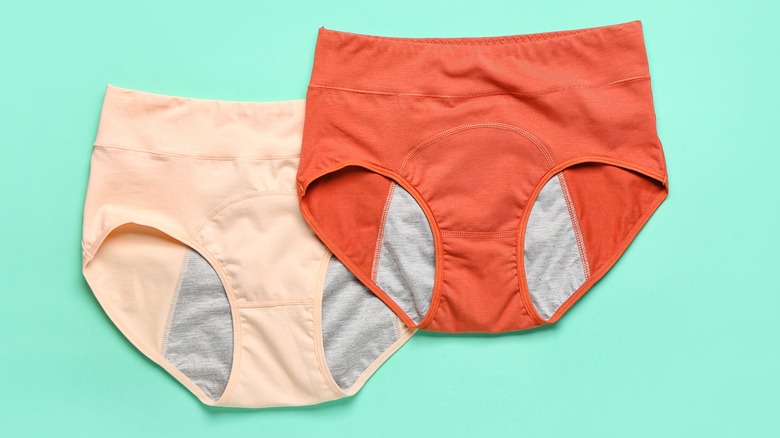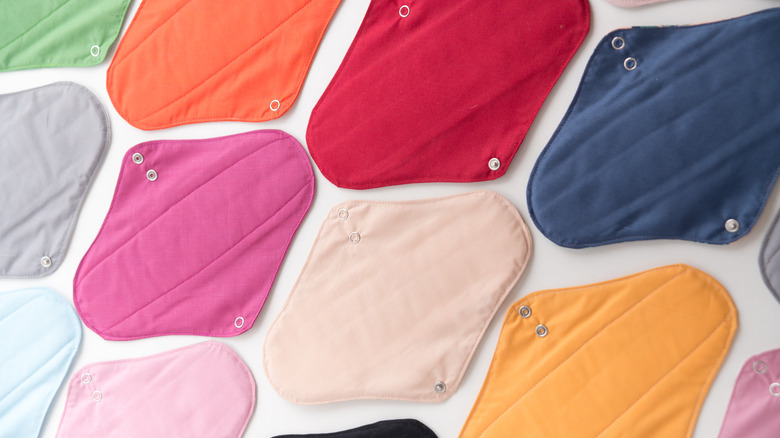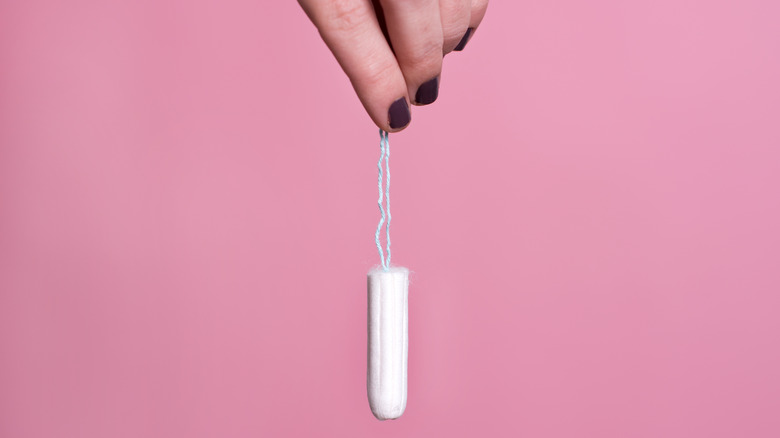The Beginner's Guide To Ditching Disposable Period Products
Unless you've been living under a rock, you're probably well aware by now that disposable period products aren't great for the environment. But why exactly? It actually all boils down (or doesn't boil down, rather) to single-use plastics. "Single-use plastic has a big footprint, both when it's made and when you throw it away," Dianne Saxe, Ontario's former environmental commissioner, explained to Global News. Sadly, plastic tampon applicators fall into that exact category. "There's a huge carbon footprint that goes into making [these products], and then they get thrown on the ground, washed into rivers, eaten by fish," Saxe added. "When they become litter, they do immense harm. They take a long time to break down and in the meantime, they're ugly, they choke fish, they block waterways."
But that's not all. Disposable pads aren't great, either. As it turns out, they take a staggering 500-800 years to break down as they are usually comprised of more than 90% plastic. But aside from being bad for the environment, research shows that disposable period products can be bad for your health as well. "Research suggests that a single conventional pad can contain as many chemicals as, something like four plastic bags," OB-GYN Dr. Lona Prasad told Prevention.
Fortunately, there is a solution. Allow us to present to you the beginner's guide to ditching disposable period products once and for all!
Menstrual cups are your friend
Move over tampons. There's a new sheriff in town, aka the menstrual cup. "A menstrual cup is a suction cup-like device that is inserted into the vagina to collect menstrual blood during a woman's period," board-certified OBGYN Faina Gelman-Nisanov told HealthNews. "It is reusable, and it can be sterilized."
It should be noted, however, that the menstrual cup isn't actually new at all. The first menstrual cup was invented way back in 1937 by actor Leona Chalmers. And yet, many women are still hesitant to give it a whirl. "I think I was just vaguely terrified... I had no idea what the cup looked like, how it worked, what made it scary — I just had some notion that it's hardcore. It isn't!" Rega Jha admitted to Vogue India about her initial aversion to the device. And as it turns out, they're highly effective when they fit properly. "You'll know if you have the right size for your body because it will feel snug, painless, and comfy when inserted," Dr. Sherry Ross told Self.
And what's more important — it's not bad for the environment or your wallet either! It's estimated that a woman will go through somewhere between 11,000 and 16,000 tampons in her lifetime. Cha-ching! Meanwhile, Dr. Tosin Odunsi told PopSugar that a single menstrual cup could be used for one whole year before it would need to be replaced. We'll let you do the math on that one...
Period undies can come in clutch
As the old saying goes, you can tell a lot about someone's underwear. And if you rock period underwear, it means you are a sustainable queen! Period underwear is comprised of several layers of cotton, nylon, merino wool, or polyester that are used in an effort to absorb period blood and simultaneously keep the area of and around the vulva dry."They're actually specifically designed with anti-microbial and moisture-wicking properties," Dr. Nicole Sparks, MD, explained during an interview with Women's Health.
And as it turns out, washing period underwear is a breeze too! Dr. Sparks recommends rinsing them first in cold water before putting them in the washing machine. "You want to make sure you clean your period underwear properly, as leftover blood can lead to bacterial growth," she advised. But do they really work? According to Dr. Jessica Shepherd, period underwear are adept at handling the same amount of blood as a tampon. Still, she cautioned women with a particularly heavy flow that they might consider changing the underwear more often than the amount of time the particular brand recommends.
However, it's important to note that in January, the period underwear brand Thinx settled a class action lawsuit wherein they were accused of using per- and poly-fluoroalkyl substances (PFAs), also known as "forever chemicals" in their products. PFAs have been linked to a laundry list of negative health implications, including causing cancer, affecting the immune system, and raising cholesterol levels.
Reduce, reuse, recycle your pads
Another solution to the disposable period products dilemma is to start using reusable pads! Yes — reusable pads are a thing, and yes, they are just as healthy and safe as their disposable counterparts. Just ask gynecologist, Dr. Anne Henderson. "Women need not have any concerns in this regard, in terms of cleanliness," she explained to Women's Health about cloth menstrual pads. "'It is a myth that there is a need to kill bacteria on the pads as sanitary pads are not sterile, regardless of whether they are disposable or reusable. Simple hygienic cleaning is all that is required –- nothing more complex than that."
But what's a girl to do when it's time to launder said reusable cloth pads? "I would recommend washing the pads in a small net wash bag to ensure they do get caught in moving parts of the washing machine," she advised. Then, simply sit back with your favorite sweet treat and a good book at let that washing machine go to work.
Applicator free tampons put the free in freedom
Yes, you can apply a tampon without an applicator, and Mother Earth will thank you for it! If you're looking for a way to reduce your carbon footprint but still prefer to use a tampon — perhaps you should consider just ditching the single-use plastic applicator altogether. But don't just take our word for it. "We prefer tampons that are made of organic, unbleached cotton without any synthetic materials in the cotton mix. Because we also strive to be environmentally conscious, we recommend applicator-free options made with fair-trade cotton..." OB-GYN Dr. Stephanie McClellan, told Cosmopolitan.
Alternatively, if you're dead set on using an applicator, you can always make the switch to a tampon that uses a cardboard applicator instead. Science education influencer Chemical Kim conducted an experiment for YouTube viewers and found without a shadow of a doubt that cardboard applications are much more environmentally friendly than their plastic counterparts. "The plastic applicator, of course, if I found this as trash on Oceanside — which I have — does not break down, and in fact, when it does start to break down, it leaves toxins in the environment," she noted. Contrastly, she found that the cardboard applicator broke down in minutes and "for the most part is very safe in the breakdown in the environment." Bravo, Chemical Kim!
The case for free bleeding
While on the subject, it would be remiss not to note that there's absolutely no shame in allowing your body to do its thing free of any products to collect the flow. While there are no proven health benefits to ditching period products altogether, some note that it can help in other ways. "Women who free bleed often describe it as liberating and feel that it is nothing they need to hide or feel ashamed of," female health expert and author Jennifer Wider explained in an interview with Women's Health. "It's really a personal choice."
Still, there is no denying that blood is a biohazardous waste, and it is imperative that one takes proper precautions to clean up after themselves in the event one were to bleed freely in a public place. According to the Red Cross, "Bloodborne pathogens, such as bacteria and viruses, are present in blood and body fluids and can cause disease in humans" and can be spread through both direct and indirect contact. So, safety first, of course!
